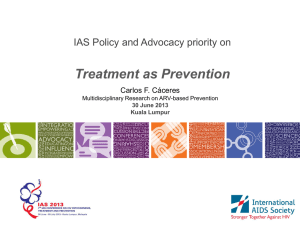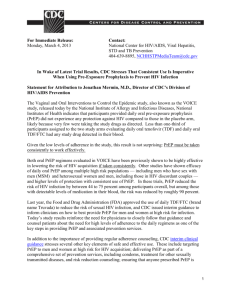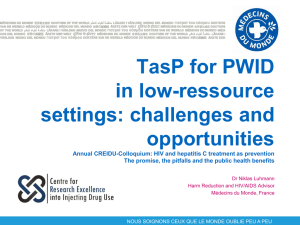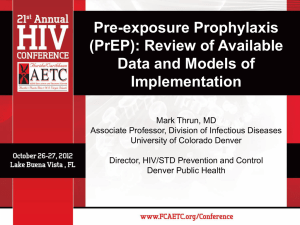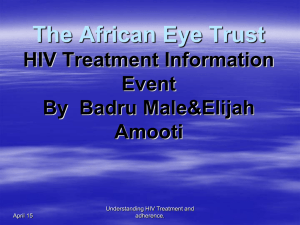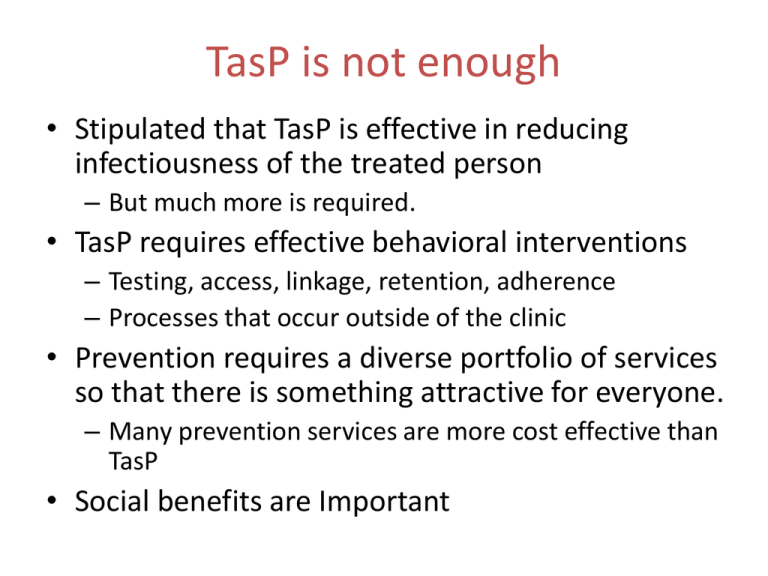
TasP is not enough
• Stipulated that TasP is effective in reducing
infectiousness of the treated person
– But much more is required.
• TasP requires effective behavioral interventions
– Testing, access, linkage, retention, adherence
– Processes that occur outside of the clinic
• Prevention requires a diverse portfolio of services
so that there is something attractive for everyone.
– Many prevention services are more cost effective than
TasP
• Social benefits are Important
CDC Cascade
MMWR December 2, 2011 / 60(47);1618-1623
SF DPH, Annual Report, 2011
Nicole Johns on 20 November 2012,
Philadelphia EMA Ryan White Part A Planning Council and HIV Prevention Group.
Nicole Johns on 20 November 2012, the Philadelphia EMA Ryan White Part A Planning Council
and the Philadelphia HIV Prevention Group.
Nicole Johns on 20 November 2012, the Philadelphia EMA Ryan White Part A Planning Council
and the Philadelphia HIV Prevention Group.
Figure 2. Estimated trends in HIV incidence
and sexual behaviour.
Phillips AN, Cambiano V, Nakagawa F, Brown AE, et al. (2013) Increased HIV Incidence in Men Who Have Sex with Men Despite High Levels of
ART-Induced Viral Suppression: Analysis of an Extensively Documented Epidemic. PLoS ONE 8(2): e55312. doi:10.1371/journal.pone.0055312
http://www.plosone.org/article/info:doi/10.1371/journal.pone.0055312
Why is TasP not working?
• Requires engagement, testing, linkage, adherence.
– Processes occur outside of clinics and clinical thinking.
– Only 28% with HIV in the US are effectively treated.
– Only 44% in San Francisco (a privileged setting).
• Risk compensation
• In couples, a third of infections arise from outside
the primary partnership.
• 10 to 50% of new infections come from acute
infections, before they can be diagnosed and
treated.
The Prevention Portfolio is Diverse:
•
•
•
•
•
HIV Testing and counseling
Condoms
Circumcision
Needle Exchange
Interactive client based counseling
– For adherence, for harm reduction
• Treatment for Positives
• PREP for Negatives
• Listen to what people want
Nothing passes through condoms: Use with confidence
Learning From Prior Success
•
•
•
•
Condom Use in Early 1980s
“Love Carefully” Uganda 1990s
Seroadaptive Behaviors Late 1990s
Common Characteristics
– Grass Roots Initiatives
– Focus on immediate concerns
– Motivated by Sexual and Social Goals
Risk Reduction During PREP Use
By Drug Concentration
Drug
Concentration
Comensurate
with Doses
HIV Risk
Reduction*
95% Confidence
Interval
2 per week
4 per week
7 per week
76%
96%
99%
56% to 96%
90% to >99%
96% to >99%
*Compared with placebo, after controlling for numbers
of partners, condom use, STIs, age, site
Anderson et al, Science Translational Medicine 2012 4:151ra125
Adequate Adherence to PREP
is Feasible
Region
Drug
Detection*
P < 0.001
(%)
Time
Points
Median
TFV-DP
Level
94%
43%
USA
Non
USA
53
894
26
19
*Detection of TFV/FTC/TFV-DP or FTC-TP in plasma or PBMC
Figure 2. Comparison of PrEP versus earlier ART initiation for
keeping couples “alive and HIV free at 50.”
Hallett TB, Baeten JM, Heffron R, Barnabas R, et al. (2011) Optimal Uses of Antiretrovirals for Prevention in HIV-1 Serodiscordant
Heterosexual Couples in South Africa: A Modelling Study. PLoS Med 8(11): e1001123. doi:10.1371/journal.pmed.1001123
http://www.plosmedicine.org/article/info:doi/10.1371/journal.pmed.1001123
Ways PrEP Could Enable Treatment
• Decreased burden on HIV treatment programs,
• Motivates HIV testing,
– Provides benefits to people hoping they are uninfected,
– Seropositives may be linked into care.
• More timely identification of acute infections,
– Allows earlier therapy initiation,
– Enables cure research for acute infection.
• Greater familiarity with antiretroviral therapy,
– A diversity of providers serving a diversity of people,
– Uninfected people become aware of therapy and HIV.
• May destigmatize therapy and the people who use it.
Social Benefits
TasP
Other Prevention
Less HIV Transmission
Decreased (nonpulmonary) TB Disease
Less HIV Transmission
Prevention other STI
transmission
Social empowerment of
women, youth, LGBT
communities,
communities of color;
housing, jobs, food;
family planning.
18
Combination Prevention
A Combination of Approaches
is Essential for Increasing
Uptake and Use of Prevention
Methods to Levels Required to
End AIDS
20

